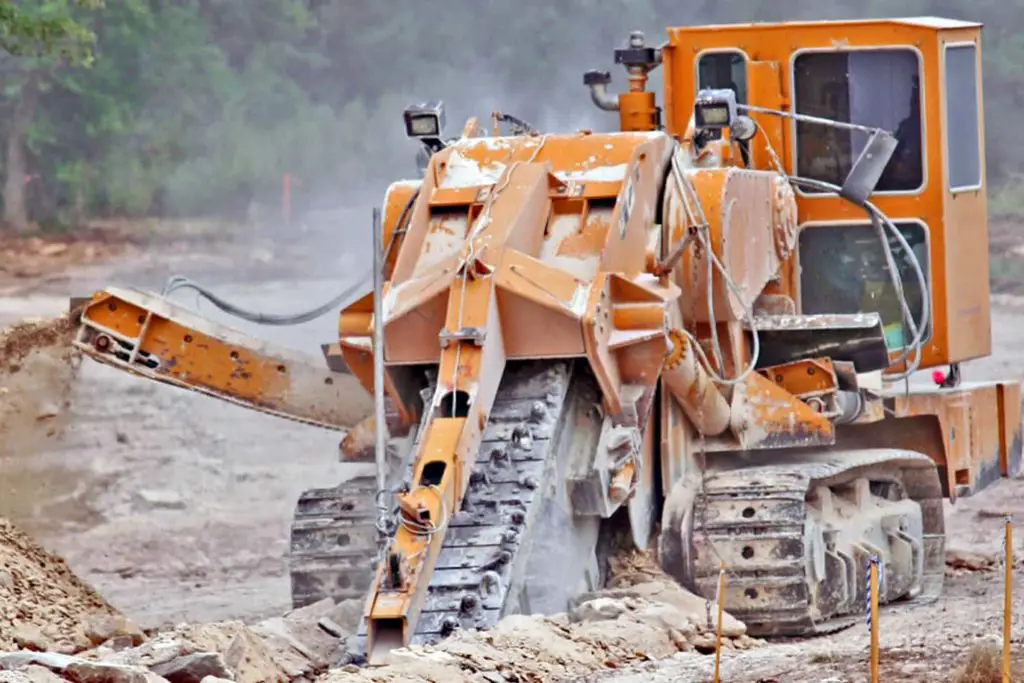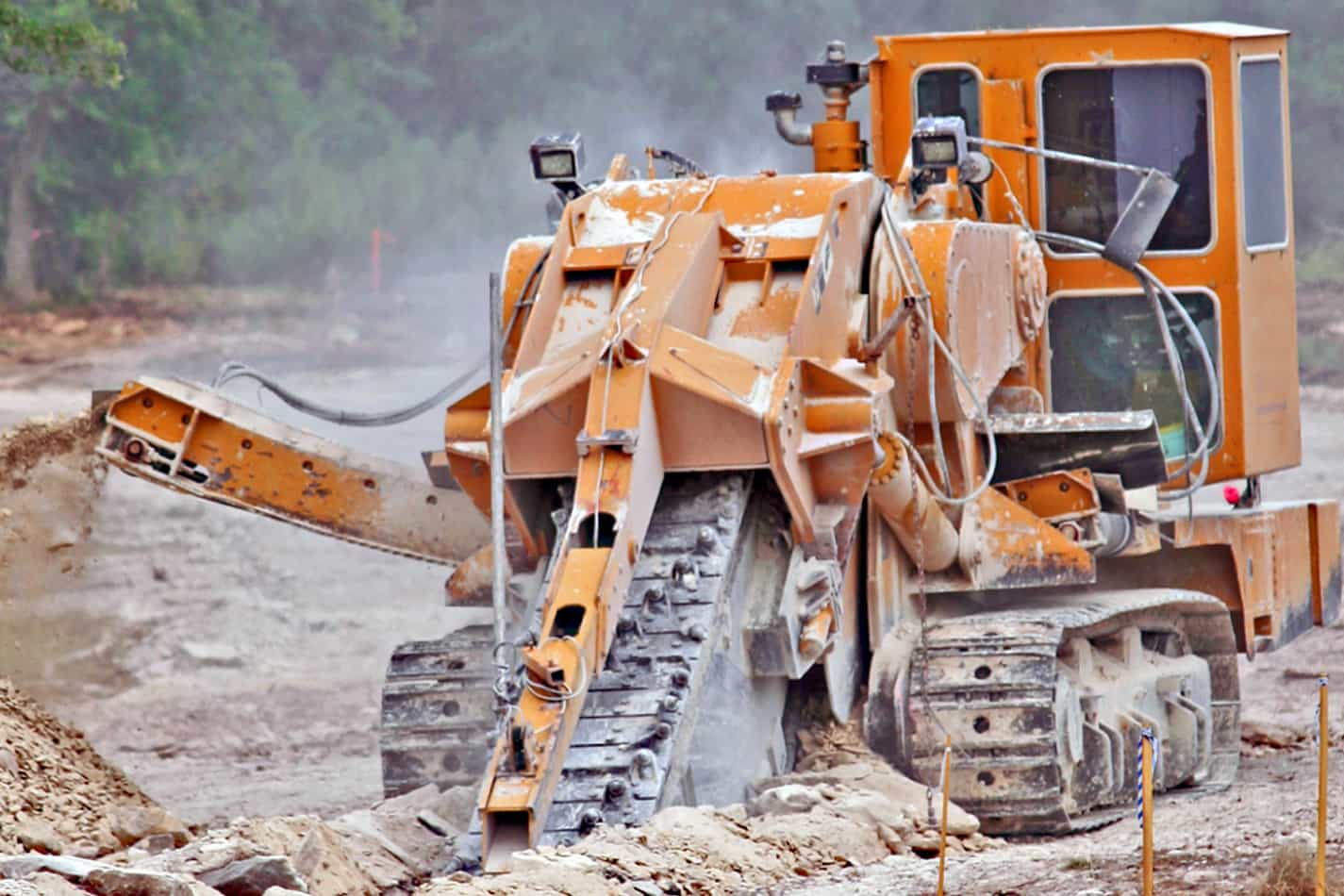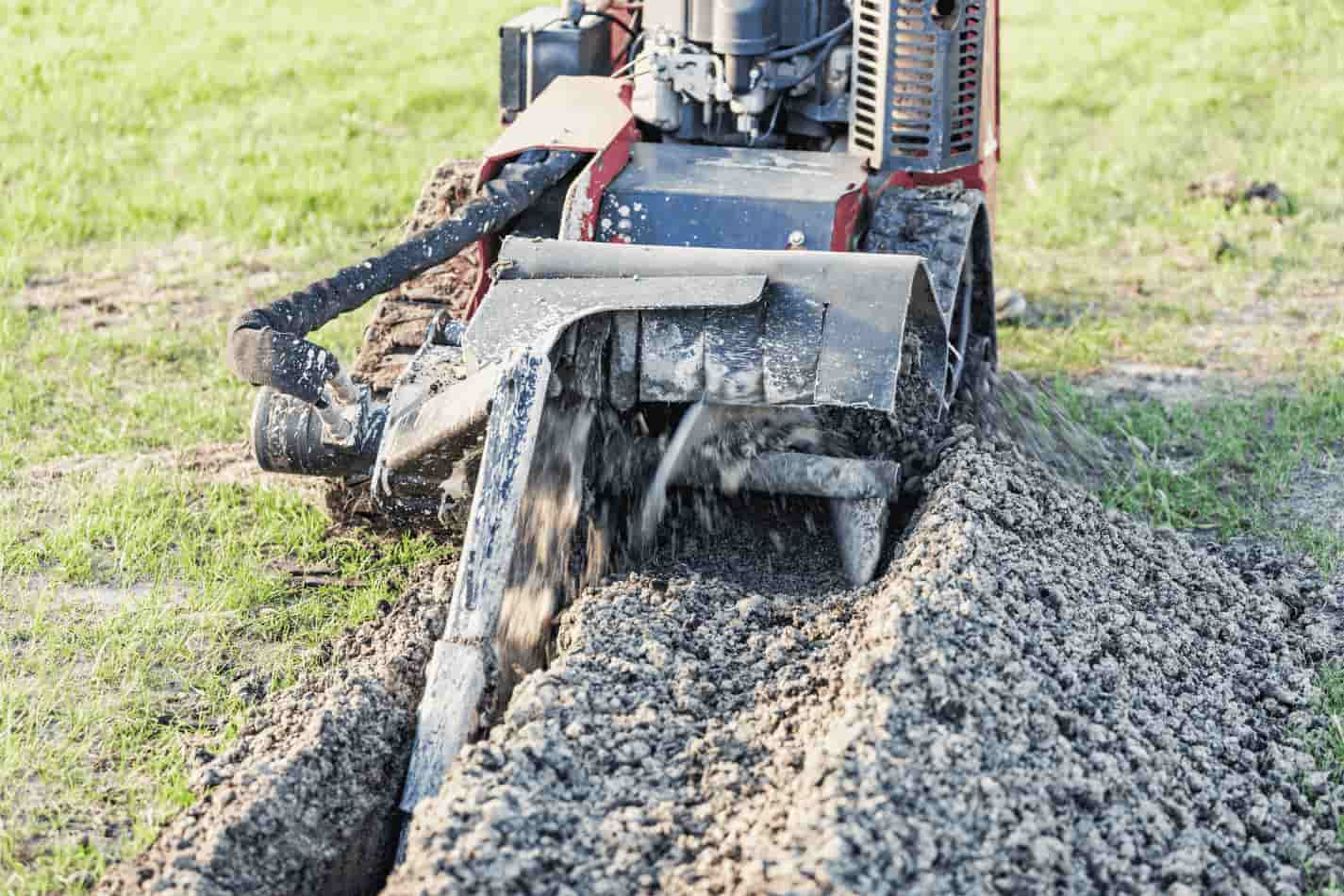Are you considering using a trencher in wet weather conditions? If so, you may be wondering if it is safe and effective to operate this machinery during the rain.
It is a common question that many individuals ask when they have an upcoming project that requires digging trenches. In this article, we will explore the various factors that affect using a trencher in the rain and offer insights into whether it is advisable or not.
Using a trencher during the rainy season can be challenging due to several factors such as soil consistency, visibility, and safety concerns. When the soil is wet, it becomes heavy and sticks together, making it difficult for the machine’s blades to cut through. This can result in slower progress or even damage to your equipment.
Additionally, poor visibility due to rainfall can increase the risk of accidents while operating the trencher. Despite these challenges, there are ways to mitigate these risks and effectively use a trencher in wet weather conditions. In this article, we will provide tips on how to operate a trencher safely and efficiently during the rainy season.

Factors Affecting Trencher Use In Wet Weather
When it comes to using a trencher in wet weather, there are several factors to consider. One of the most important is trencher maintenance. A well-maintained trencher is more likely to perform efficiently in wet conditions than one that has not been properly cared for. Routine checks and cleaning of the machine’s parts can help prevent breakdowns and keep it running smoothly.
Another factor to consider is equipment durability. Trenchers that are built with high-quality materials and designed to withstand harsh weather conditions are more likely to be effective in wet weather than those that are not. It’s essential to choose a trencher that can handle the specific conditions you’ll be working in, whether it’s rain, snow, or mud.
Despite these considerations, using a trencher in the rain can still pose risks. Wet conditions can make the ground unstable, which may cause the machine to tip over or become stuck.
Additionally, damp soil can create challenges when trying to create a clean trench line. It’s important for operators to take extra precautions when working with a trencher in wet weather, such as reducing speed and being aware of their surroundings.
Soil Consistency And Its Impact On Trencher Operations
The moisture content of the soil is a crucial factor that determines whether a trencher can be used in the rain. When the soil is too wet, it becomes sticky and clumpy, making it difficult for the trencher to cut through. The excess water can also cause erosion and affect the stability of the machine. Therefore, it is recommended to avoid using a trencher during heavy rainfall or when the soil is saturated.
Soil compaction is another factor that affects trencher operations. Compacted soil reduces the amount of air spaces between particles, making it harder for the cutting teeth of a trencher to penetrate. In such cases, more horsepower may be required to operate the machine, leading to higher fuel consumption and increased wear and tear on equipment components. To minimize these effects, it is recommended to use specialized equipment designed for compacted soils or employ techniques such as loosening the soil with a harrow beforehand.
In summary, using a trencher in rainy conditions requires careful consideration of both moisture content and soil compaction. A proper assessment of these factors will ensure efficient operation while minimizing potential damage to equipment and terrain.
By following these guidelines and utilizing appropriate tools and techniques, operators can maximize productivity while maintaining safe working conditions on site.
Visibility Concerns And Safety Risks
When trenching in the rain, visibility concerns and safety risks must be taken into account.
Rain gear such as waterproof jackets, pants, and boots are essential for keeping workers dry and visible on the job site. Wearing reflective clothing can also help improve visibility in low light conditions. It’s important to note that not all rain gear is suitable for trenching work. Clothing that is too loose or bulky can become caught in equipment, causing accidents.
In addition to proper rain gear, equipment maintenance is crucial when working in wet conditions. Moisture can cause damage to machines, so it’s important to regularly check and clean equipment after use. Electrical components should be covered or kept away from water sources to avoid electrical hazards. Inspecting trenches before work begins is also important to ensure there aren’t any hidden hazards such as unstable soil or standing water.
Overall, trenching in the rain requires extra precautionary measures for worker safety.
Proper rain gear and equipment maintenance are crucial components of a safe work environment in wet conditions. It’s important for workers to remain vigilant and aware of their surroundings at all times while on the job site.
Mitigating Risks: Tips For Safe And Effective Trencher Use In The Rain
Visibility concerns and safety risks are always a priority when using a trencher. However, when it comes to working in the rain, additional precautions must be taken.
Rainy day preparations should include wearing appropriate clothing and footwear that can withstand wet conditions. It’s also essential to ensure that all safety equipment is functioning correctly, such as hard hats, gloves, and goggles.
Equipment maintenance is crucial when using a trencher in the rain. Wet conditions can cause damage to the machinery, leading to costly repairs or even accidents. Before operating the trencher in wet weather, be sure to inspect all parts thoroughly for signs of wear and tear. Check for any loose bolts or screws that may need tightening and ensure that all electrical components are dry and secure.
Mitigating risks during trenching operations in the rain requires attention to detail and proper planning. One way to reduce the risk of accidents is by slowing down the speed of the trencher when working in wet conditions. This will allow for better control of the machine while minimizing the risk of slipping or sliding on slick surfaces.
Additionally, consider setting up temporary barriers around the work area to prevent water from pooling around trenches and creating hazardous conditions.
By following these tips for safe and effective use of a trencher in rainy weather, workers can avoid accidents while still getting their job done efficiently. Remember always; safety should be a top priority no matter what weather conditions you’re working in!
What Precautions Should I Take When Trenching in Wet Conditions?
When powering through wet trenching conditions, it is crucial to ensure safety by taking necessary precautions. Firstly, wear appropriate protective gear, including waterproof clothing, gloves, and boots with good traction. Inspect your equipment for any damage or malfunction before starting the trenching process. Use caution and maintain a slow, steady pace to reduce slips and falls. Regularly check the depth and stability of the trench and be mindful of any water accumulation. Finally, avoid electrical hazards by keeping equipment away from water sources and using proper grounding techniques. Stay vigilant and prioritize safety to minimize risks when trenching in wet conditions.
Conclusion: Is It Advisable To Use A Trencher In The Rain?
While operating a trencher in rainy weather conditions, there are certain precautions that one should take to ensure the safety of both the operator and the equipment.
Firstly, it is important to note that trenching in wet soil can be more difficult due to the increased weight of the mud. This can cause strain on the machine’s engine and transmission system. Therefore, it is advisable to use a trencher with a higher horsepower engine for such conditions.
Secondly, before starting work in wet weather, inspect the equipment thoroughly. Water can damage electrical components and accelerate rust formation on metal parts. It is essential to check all electrical connections and lubricate moving parts to prevent corrosion from moisture exposure.
Lastly, when trenching in the rain, it is crucial to monitor any changes in weather patterns. Lightning strikes pose a significant risk when working outdoors during thunderstorms. Always keep an eye on your surroundings and remain alert at all times.
To make maintenance easier after use in rainy weather conditions, consider cleaning off any dirt or debris from the machinery as soon as possible. This will prevent rust build-up and other problems caused by prolonged exposure to moisture.
In summary, while using a trencher in rainy weather conditions may be necessary at times, it is essential to take proper precautions beforehand. By adhering to these tips for rainy weather precautions and equipment maintenance tips, you can minimize potential risks and prolong your trencher’s lifespan significantly.
Frequently Asked Questions
Can You Use A Trencher In Heavy Rain And Thunderstorms?
When operating a trencher, it is important to consider safety measures and potential soil erosion. In heavy rain and thunderstorms, these concerns are heightened.
Proper precautions should be taken to ensure the safety of both the operator and anyone in the surrounding area.
Additionally, the excess water can increase the likelihood of soil erosion, causing damage to nearby landscapes.
When considering whether or not to use a trencher in such conditions, it is essential to prioritize safety and environmental impact above all else.
What Precautions Should Be Taken When Using A Trencher In Wet Weather?
As the saying goes, ‘When it rains, it pours.’ This holds true for those operating trenchers during wet weather conditions.
It’s crucial to take proper precautions to avoid accidents and mishaps. One must ensure they wear appropriate attire that provides ample protection from rain and mud, such as waterproof boots and a rain jacket. Proper footing precautions should also be taken to prevent slips and falls.
Additionally, it’s vital to rainproof equipment and keep them dry in case of sudden downpours. Shelter options must also be considered, such as using tarps or tents to protect workers and equipment from heavy rain or thunderstorms.
As a technical writer, it is necessary to emphasize the importance of following these guidelines to ensure safety and efficiency while working with trenchers in wet weather conditions.
Can Trencher Blades Become Damaged In Wet Soil?
Blade durability can be impacted by soil moisture when using a trencher. Wet soil can cause the blades to dull or even break over time, which can lead to costly repairs and downtime for the machine.
Therefore, it is important to take precautions when operating a trencher in wet weather conditions. One solution is to adjust the blade speed and pressure to compensate for the increased resistance caused by the wet soil.
Additionally, regularly inspecting and maintaining the blades can help ensure their longevity and minimize damage from moisture.
Does Trenching In Wet Soil Affect The Quality Of The Trench?
It is a truth universally acknowledged that wet soil and trenching do not make for the happiest of bedfellows.
The effects on productivity are well-known, with muddied boots and sopping clothes causing no end of discomfort for those in the trenches.
However, it’s not just human comfort that’s at stake here.
Trenching in wet soil can also have a significant impact on soil structure, potentially leading to compaction and reduced permeability.
As such, while trenching in the rain may seem like a tempting option, it’s important to consider the wider implications before taking the plunge.
Are There Any Additional Maintenance Requirements For Trenchers Used In The Rain?
When it comes to rain trencher maintenance, there are a few things to keep in mind.
First and foremost, it’s important to take wet weather precautions when using a trencher in the rain.
This includes checking the machine for any signs of water damage, such as rust or corrosion, and making sure all electrical components are properly insulated.
Additionally, it’s important to clean the trencher thoroughly after each use in wet conditions to prevent buildup of mud and debris that could lead to clogs or other issues.
Regular maintenance checks should also be scheduled to ensure that all parts are functioning properly and any necessary repairs or replacements can be made promptly.
By following these guidelines, you can help ensure that your trencher stays in top condition even when used in rainy weather conditions.
Conclusion
In conclusion, yes, you can use a trencher in the rain. However, precautions need to be taken to ensure safety and prevent damage to the equipment.
When operating a trencher in wet weather, it is important to wear appropriate clothing, use non-slip footwear, and avoid working near power lines or other electrical sources.
While trenching in wet soil may affect the quality of the trench and potentially damage blades, proper maintenance can help mitigate these issues. It is important to clean and dry the equipment thoroughly after use in wet conditions and regularly inspect blades for any signs of wear or damage.
As with any machinery, proper usage and maintenance are essential for optimal performance. By following safety protocols and taking necessary precautions, using a trencher in the rain can be done effectively and efficiently.
As the old saying goes, ‘An ounce of prevention is worth a pound of cure.’




